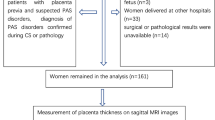Abstract
Objective
To identify if placental thickness measured from MRI images correlates with placenta accreta spectrum (PAS) disorders.
Methods
Placental thickness of 245 patients was retrospectively measured from October 2016 to March 2020. The measurement was made at the thickest portion of the placenta on the mid-sagittal plane of the placenta from MRI by two independent radiologists. Surgical report and pathology of the delivered placenta were used as a reference standard. Association between clinical features, placental thickness, and PAS disorders was evaluated with univariate and multivariate analyses. The inter-reader and intra-reader reproducibility of the measurements and receiver operating characteristic curve analysis were also performed.
Results
Placental thickness was significantly higher in patients with PAS disorders (3.45 cm) than that in patients without PAS disorders (2.90 cm) (p < 0.05). Multivariate analyses revealed that prior cesarean section, placenta previa, and placental thickness > 4 cm were independent risk factors for PAS disorders. The inter-reader and intra-reader reproducibility of placental thickness measurement were 0.979 (95% CI 0.960–0.989) and 0.981 (95% CI 0.9640–0.990), respectively.
Conclusion
The reproducibility of the measurement made from MRI images was high between two radiologists. Patients with PAS disorders had increased placental thickness. Placental thickness > 4 cm correlated with PAS disorders.




Similar content being viewed by others
References
Jauniaux E, Ayres-de-Campos D. FIGO Placenta Accreta Diagnosis and Management Expert Consensus Panel.FIGO consensus guidelines on placenta accreta spectrum disorders: introduction .Int J Gynaecol Obstet, 2018 ,140: 261-264
Solheim KN, Esakoff TF, Little SE,et al. The effect of cesarean delivery rates on the future incidence of placenta previa, placenta accreta, and maternal mortality. J Matern Fetal Neonatal Med,2011, 24:1341–1346
Chen T, Xu XQ, Shi HB, et al. Conventional MRI features for predicting the clinical outcome of patients with invasive placenta. Diagn Interv Radiol.2017, 23:173–179
Jauniaux E, Kingdom JC,Silver RM. A comparison of recent guidelines in the diagnosis and management of placenta accreta spectrum disorders.Best Practice & Research Clinical Obstetrics and Gynaecology,2021,72:102-116
Bodelon C, Bernabe-Ortiz A, Schiff MA, Reed SD.Factors associated with peripartum hysterectomy. Obstet Gynecol.2009, 114:115–123
Jin R, Guo Y, Chen Y. Risk factors associated with emergency peripartum hysterectomy. Chin Med J (Engl),2014, 127:900–904
Gielchinsky Y, Rojansky N, Fasouliotis SJ, Ezra Y. Placenta accreta—summary of 10 years: a survey of 310 cases. Placenta,2002 23:210–214
Upson K, Silver RM, Greene R, Lutomski J, Holt VL. Placenta accreta and maternal morbidity in the Republic of Ireland,2005-2010. J Matern-Fetal Neonat Med: Off J Eur Assoc Perinat Med Fed Asia Ocean Perinat Soc Int Soc Perinat Obstet. 2014;27(1):24–29.
Fox KA and Lee W.Prenatal Diagnosis and Evaluation of Abnormal Placentation.CLINICAL OBSTETRICS AND GYNECOLOGY,2017,60(3):596-607
Li Y,Choi HH, Goldstein R, et al.Placental thickness correlates with placenta accreta spectrum (PAS) disorder in women with placenta previa.Abdominal Radiology,2021,46(6):2722-2728
Jha P,Pōder L,Bourgioti C,et al.Society of Abdominal Radiology (SAR) and European Society of Urogenital Radiology (ESUR) joint consensus statement for MR imaging of placenta accreta spectrum disorders.European Radiology .2020, 30:2604-2615
Pijnenborg R, Brosens I, Romero R (2010) Placental bed disorders:basic science and its translation to obstetrics. Cambridge University Press
Alamo L, Anaye A, Rey J, et al. Detection of suspected placen tal invasion by MRI: do the results depend on observer' experience? . Eur J Radiol,2013,82:e51-e57
Bhide A,Laoreti A, Agten AK, et al.Lower uterine segment placental thickness in women with abnormally invasive placenta.Acta Obstetricia et Gynecologica Scandinavica,2018, 98(1):95-100
Zaitoun MM, El Behery MM, Abd El Hameed AA, et al, Does cervical length and the lower placental edge thickness measurement correlates with clinical outcome in cases of complete placenta previa? Arch Gynecol Obstet ,2011,284:867-873
Liu Z, Wei Y, Dai Q,et al; Antenatal Sonographic Diagnosis and Clinical Signifcance of Placenta Previa Accreta After Cesarean Section. Zhongguo Yi Xue Ke Xue Yuan Xue Bao, 2017,30;39(5):693–698
Chen D, Xu J, Ye P, et al. Risk scoring system with MRI for intraoperative massive hemorrhage in placenta previa and accreta. JMRI,2020,51:947-958
Craven CM, Zhao L, Ward K. Lateral placental growth occurs by trophoblast cell invasion of decidual veins. Placenta. 2000;21(2-3):160-169.
Author information
Authors and Affiliations
Corresponding author
Ethics declarations
Conflict of interest
All authors declare that they have no conflict of interest to disclose.
Additional information
Publisher's Note
Springer Nature remains neutral with regard to jurisdictional claims in published maps and institutional affiliations.
Rights and permissions
About this article
Cite this article
Lu, T., Wang, Y., Guo, A. et al. Correlation of placental thickness and PAS disorders: findings from MRI. Abdom Radiol 47, 1150–1156 (2022). https://doi.org/10.1007/s00261-022-03420-9
Received:
Revised:
Accepted:
Published:
Issue Date:
DOI: https://doi.org/10.1007/s00261-022-03420-9




